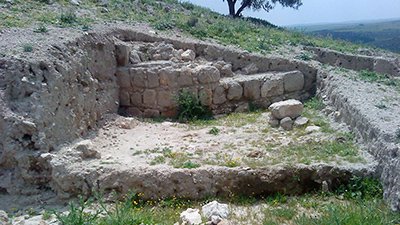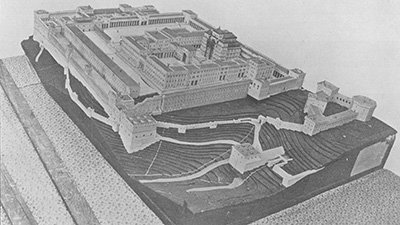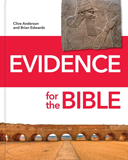Do Ancient Canaanite Remains Discredit the Bible?
A recent Independent news article is titled “Bible Says Canaanites Were Wiped out by Israelites but Scientists Just Found Their Descendants Living in Lebanon.”1 The author essentially claims that objective “science” has again successfully contradicted the claims of the Bible. While this tantalizing assertion may appeal to skeptics, it fails to deal truthfully with the biblical record and may also place too much weight on the genetic evidence.
This news article popularizes the findings of a technical article published in the American Journal of Human Genetics.2 The researchers wanted to explore the origin of the Canaanite population and its relation to present-day inhabitants of the Levant (the lands bordering the eastern Mediterranean Sea, otherwise known as the “land of Canaan” including the “Promised Land”). Their process was to compare the DNA sequences of ancient individuals against samples of present-day Lebanese inhabitants. Among many findings, the researchers conclude that “present-day Lebanese derive most of their ancestry from a Canaanite-related population, which therefore implies substantial genetic continuity in the Levant since at least the Bronze Age.”3
Both articles incorrectly assume that Canaanite civilizations were largely if not completely eliminated with the Israelites’ conquest of the land of Canaan. How can modern individuals trace their ancestry to a people group that has supposedly been extinct for millennia? What is the evidence and what does the Bible have to say about this? Furthermore, was God righteous in commanding the Israelites to kill the Canaanite populations?
Canaan, Son of Ham
After the global Flood (ca. 2348 BC4), the three sons of Noah and their wives became the forebears of the new human population (Genesis 7:7, 13, 21–23). Ham, one of Noah’s sons, was the father of four sons: Cush, Egypt, Put, and Canaan (Genesis 10:6). It is from this Canaan that the various Canaanite peoples came, including the Sidonians, Hittites, Jebusites, Amorites, and others (10:15–18). These people lived in the territory of present-day Lebanon and Israel (10:19).
What Is the Genetic Evidence?
Recent excavations in the biblical city of Sidon (present-day Saida) in Lebanon have uncovered a total of 123 burials of ancient individuals.5 Eight of these burials were included in the present study, from which it is claimed that “five whole genomes” were sequenced.6 These eight burials were dated by radiocarbon methods and by archaeological indicators to be from approximately 3,700 years ago (ca. 1700 BC).7 Radiometric dating issues aside, being several centuries before the conquest, one would expect these people to be identified as Canaanite, though even this assumption does not reflect the possible intermarriage and slave trading that the seafaring Sidonians had with other nations. Other factors that would contribute to genetic mixing between ancient and present-day inhabitants of Lebanon include various historical peoples who came in and conquered the region, including Egyptians, Hittites, Arameans, Assyrians, Babylonians, Persians, Macedonians, Romans, Arabians, Turks, and others.
To explore the relationship of present-day Lebanon inhabitants, the researchers sequenced the genomes of 99 individuals coming from Christian, Druze, and Muslim sects of Lebanon.8 They claim the comparison yielded the result that 90% of present-day DNA was inherited from ancient Canaanite people, while the remaining portion indicates traces of Assyrian, Persian, and Macedonian populations.9
Watch Ken Ham and Bodie Hodge discuss this issue on Answers News.
How valid are these claims of ancestry? Dr. Nathaniel Jeanson, research biologist for Answers in Genesis, writes the following critique of this study:
The genetic conclusions of this article are highly dependent on the quality of the DNA samples that the authors obtained. The primary samples are bones from Sidonian individuals who died thousands of years ago. Without knowing anything else, this fact makes me suspicious. When I work with DNA in the lab, I tend to throw away samples that have been sitting in the freezer for more than a year; they tend to not give reliable results. How much more unreliable will DNA sequences be that have been sitting in fluctuating environmental conditions for thousands of years.
Consistent with my suspicions, the authors show an intriguing tree of DNA relationships in Figure S11 that is based on the number of DNA differences among the individuals. In this tree, both modern and ancient individuals are represented. The modern individuals appear as you might expect, but the ancient Sidonian individuals look like they’ve undergone more mutations than modern individuals. Since DNA acts like a clock, this implies that the clock has been ticking longer in individuals that died thousands of years ago! This doesn’t make good biological sense. Instead, the more likely explanation is that the DNA differences in the ancient Sidonians are not actually mutations but represent degraded DNA.
So the genetic claims made by the researchers are suspect. But even if predominant Canaanite ancestry could be proven, having them related to those in Lebanon, Persia, Assyria, Macedonia, and so on is to be expected. Nevertheless, would any of this compel us to reject the Bible’s historical narrative? Didn’t the Israelites utterly destroy the Canaanites?
What Did the Israelites Accomplish in the Conquest?
Since the 1800s, archaeological exploration in the land of the Bible has alternately been used to overwhelmingly confirm or, in a few disputed cases, discredit the biblical record.10 This is especially true of the Conquest of the land of Canaan under Joshua. A popular misconception of this military campaign is that it resulted in the wholesale destruction of a civilization. With this assumption, archaeologists would expect to find evidence of such things as burned wood and broken pottery, followed by the evidence of the material culture of the new civilization. The authors of the study mention this surprising lack of destruction layers:
No archaeological evidence has so far been found to support widespread destruction of Canaanite cities between the Bronze and Iron Ages: cities on the Levant coast such as Sidon and Tyre show continuity of occupation until the present day.11
But one of the promises that God made to Israel in the Conquest was that he would give them “great and good cities that you did not build, and houses full of all good things that you did not fill, and cisterns that you did not dig, and vineyards and olive trees that you did not plant” (Deuteronomy 6:10–11). God did not tell them to destroy cities, but to leave them structurally intact. While the Israelites did smite the inhabitants of many cities during their campaigns, there were only three cities that they completely destroyed: Jericho (Joshua 6:24), Ai (8:28), and Hazor (11:1312).
God did not tell them to destroy cities, but to leave them structurally intact.
Furthermore the Israelite Conquest under Joshua took place mainly in the hill country and Galilee. The plains and other coastal regions from Gaza in the south to Sidon in the north remained largely untouched by the Israelites and remained under Canaanite control. There is no biblical record of the Israelites conducting military expeditions to the coastal cities of Tyre and Sidon, so we would not expect archaeological excavations of these cities to show evidence of layers of burned items or destruction caused by Israel.
But Didn’t Joshua Do Everything that God Had Commanded?
In the Independent article, the author cites Joshua 11:15, “Just as the Lord had commanded Moses his servant, so Moses commanded Joshua, and so Joshua did. He left nothing undone of all that the Lord had commanded Moses.” It would appear that Joshua and his army had finished all military campaigns and they could now settle down in peace. Truly the extensive victories Israel had enjoyed by God’s hand in the land had resulted in the defeat of 31 Canaanite kings (Joshua 11:23, 12:7–24). But after these initial successes, God told Joshua that
there remains yet very much land to possess. This is the land that yet remains: all the regions of the Philistines, and all those of the Geshurites . . ., all the land of the Canaanites, and Mearah that belongs to the Sidonians, to Aphek, to the boundary of the Amorites, and the land of the Gebalites, and all Lebanon, toward the sunrise, from Baal-gad below Mount Hermon to Lebo-hamath, all the inhabitants of the hill country from Lebanon to Misrephoth-maim, even all the Sidonians. (Joshua 13:1–6, emphasis added)
This unconquered territory included the Philistine coastal plain north through the Sharon Plain and into present-day Lebanon. Joshua had not conquered these areas, so it was left to the Israelites to finish possessing the land.13 God said the conquest of the Canaanite population would happen gradually (Exodus 23:29–30) until he would “blot them out” (verse 23; cf. 34:11). After the death of Joshua, the people continued to have some success in driving out the Canaanites (Judges 1:1–26), but then began a series of failed or abandoned military campaigns (verses 27–36). The Israelites also grew tired of warfare, and instead of driving out the Canaanite inhabitants of the land, they often just turned them into forced labor, and let the Canaanites live among them (Joshua 16:10, 17:13). The end result was that many of these Canaanite nations continued to exist alongside Israel, and God punished Israel by allowing these nations to “become thorns in your sides, and their gods shall be a snare to you” (Judges 2:3, 3:1-4; cf. Numbers 33:55–56; Psalm 106:34–39). This brings us then to a final question of why the Canaanite people had to be destroyed when Israel came into the land.
Why Did God Command the Destruction of the Canaanites?
The author of the Independent article begins his analysis with a quote from Richard Dawkins’ book The God Delusion. In this book, Dawkins notoriously asserts, “The God of the Old Testament is arguably the most unpleasant character in all fiction,” and he goes on to decry God’s so-called unrighteous acts toward men. But is God wrong to judge those who do wrong? And if it is wrong to judge wrong, what is right? What standard of morality are we left with?
God made a covenant with Abraham in part to make of him a great nation that would dwell in the land of Canaan. God promised that Abraham’s descendants would sojourn in Egypt for several generations before returning to take possession of the land, “for the iniquity of the Amorites is not yet complete” (Genesis 15:16). Here God takes the Amorites to stand for the whole of the Canaanite population, which he intended to remove to make a place for his people (Exodus 23:23, 33; Numbers 33:53; Deuteronomy 1:8).
But in the cities of these peoples that the Lord your God is giving you for an inheritance, you shall save alive nothing that breathes, but you shall devote them to complete destruction, . . . as the Lord your God has commanded, that they may not teach you to do according to all their abominable practices that they have done for their gods, and so you sin against the Lord your God. (Deuteronomy 20:16–18, emphasis added)
Why were the Canaanites condemned? For the same reason that anyone stands condemned before the Lord: sin. Leviticus 18 lists several “abominations” committed by the Canaanites in the land (cf. Romans 1:24–27). The Canaanites would not worship the God who had revealed himself, and instead they chose for themselves “other gods” (Deuteronomy 7:4–5). The God of heaven is rightly jealous for his own glory and he wants all people to worship him (Romans 1:19–22; cf. 1 Thessalonians 1:9). God also sought to remove the Canaanites in order to protect his chosen people from this idolatry (Deuteronomy 7:1–6). Sadly, because of Israel’s failure to obey God’s commands, these pagan nations became a snare to them, corrupting their worship and faithfulness before the Lord (Leviticus 18:24–25). God told the Israelites to drive them out and destroy them.
The localized destruction of the Canaanites was just as righteous as God’s destruction of all humanity in the global Flood. Why? Because “the wages of sin is death” (Romans 6:23), just as God promised to Adam and Eve (Genesis 2:16–17). That anyone is allowed to live even for a moment is a mercy of God, whereby he offers time for us to repent of our sins and trust in his grace (Luke 13:3; Romans 2:4; 2 Peter 3:9).
Was grace offered to the Canaanites?
Was grace offered to the Canaanites? Yes, for those who would repent and believe God. The very first battle in the Promised Land introduced us to Rahab, a Canaanite prostitute who lived in Jericho (Joshua 2:1). She and her family were spared from the destruction of the city and its inhabitants because of her new obedient faith in God (Joshua 6:25; Hebrews 11:31; James 2:25). What’s more, Rahab even has a prominent place in the genealogy of David and the Lord Jesus Christ (Matthew 1:5).
Hundreds of years later, Lebanon became one of the few nations that joined in a firm alliance with Israel (2 Samuel 5:11; 1 Kings 5:12). Hiram king of Tyre, one of David and Solomon’s best friends, helped Solomon build the Temple (1 Kings 5:1–12) where God’s very presence would dwell. Hiram publicly praised and acknowledged the God of Israel as the Creator (2 Chronicles 2:12). Many of Hiram’s people joined with Solomon’s craftsmen and lived in Israel while building the Temple (2 Chronicles 2:14–18). And it is almost certain that they stayed for the dedication and heard and saw the Shekinah glory of the Lord (2 Chronicles 7:1–5). Hiram serves as a witness that God very clearly offered mercy to those in Lebanon who turned to him.
And one of the very few times that the Lord Jesus Christ praised someone for great faith was regarding a Canaanite woman from the region of Tyre and Sidon (Matthew 15:21–28). Jesus not only commended her faith but also instantly healed her daughter.
So let us trust the historical record God provided for us in the Bible, and receive the grace offered to us by repentance and faith in the Lord Jesus Christ. Our God is holy and just, but he is merciful to those who humbly trust him and obey his Word.
Footnotes
- Ian Johnston, “Bible Says Canaanites Were Wiped out by Israelites but Scientists Just Found Their Descendants Living in Lebanon,” The Independent, July 27, 2017, http://www.independent.co.uk/news/science/bible-canaanites-wiped-out-old-testament-israelites-lebanon-descendants-discovered-science-dna-a7862936.html.
- Marc Haber et al., “Continuity and Admixture in the Last Five Millennia of Levantine History from Ancient Canaanite and Present-Day Lebanese Genome Sequences,” The American Journal of Human Genetics 101 (July 27, 2017): 1–9, doi:10.1016/j.ajhg.2017.06.013.
- Ibid., 1. There are potential geopolitical implications of this statement, as when the late Yasser Arafat claimed his ancestors were “the Canaanites and the Jebusites,” thereby asserting a right to Jerusalem (Jebus) and Canaan that predates Israel’s claim (Eric H. Cline, “Politics and Propaganda: The Use and Abuse of Ancient Conflicts in the Modern Battle for Jerusalem,” The Bible and Interpretation, September 2004, http://www.bibleinterp.com/articles/Cline-Use-Abuse_of_Ancient_Conflicts_1.shtml.)
- See David Wright, “Timeline for the Flood,” Answers in Genesis, March 9, 2012, https://answersingenesis.org/bible-timeline/timeline-for-the-flood/.
- As of the 2012 excavation year; see “Year 2012,” Sidon Excavation, http://www.sidonexcavation.com/index.php/2016-01-07-16-38-41/seasons/year-2012.
- Haber et al., “Continuity and Admixture,” 1; and Figure S2.
- Ibid., 2 (Table 1).
- Ibid., Figure S5. For certain of their tests they specifically chose the present-day Lebanese Christian population because that group “has been shown to be relatively isolated and had no significant admixture in recent times with neighbouring populations” (Figure S7). The tumultuous politics of Lebanon over the past century together with a large immigration of non-Lebanese individuals could possibly skew the genetic identity of the population sample.
- Ibid., 6.
- This controversy is partly due to the fact that most ancient cities lie under present-day cities which are largely occupied. Relatively little of the Bible lands have been excavated sufficient to warrant such sweeping generalizations. But what has been discovered fits well within the biblical narrative.
- Haber, “Continuity and Admixture,” 2. In the present context the transition from Bronze Age to Iron Age typically coincides with the possession of Canaan by the Israelites.
- Joshua 11:13 indicates that “none of the cities that stood on mounds did Israel burn, except Hazor alone; that Joshua burned.” This statement evidently refers to the other cities (verse 12) of the alliance organized under the king of Hazor (verse 10), not to the entire scope of the Conquest which began with the destruction of Jericho (6:24).
- As Winston Churchill said, “Now this is not the end. It is not even the beginning of the end. But it is, perhaps, the end of the beginning.” (Winston Churchill, in a speech at the Lord Mayor’s Luncheon given November 10, 1942, cited from “The End of the Beginning,” The Churchill Society, http://www.churchill-society-london.org.uk/EndoBegn.html.)
Recommended Resources

Answers in Genesis is an apologetics ministry, dedicated to helping Christians defend their faith and proclaim the good news of Jesus Christ.
- Customer Service 800.778.3390
- © 2024 Answers in Genesis








